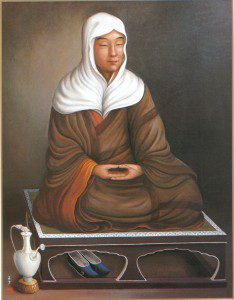The Japanese monk Saicho was born on this day in 767. A signal figure in Japanese Buddhism he was the founder of the Tendai school in that country. Rather more important for me is how in response to the tight control of the ordination platform at Todaiji in Nara which was required for Vinaya monastic ordination, he petitioned the imperial court for permission to establish a new ten precept ordination model based in the bodhisattva precepts contained in the apocryphal Chinese Bramajala Sutra. The petition was approved by the Emperor in 822, sadly a few days after his death.
That model would go through numerous shifts over the many years and in time become the normative ordination model for all Buddhist schools in Japan, completely replacing the Vinaya. This included both the Rinzai and the Soto Zen schools, the later which slightly expanded the original ten vows to a sixteen vow model.
With the exception of the Jodo Shin school which allowed married clerics from the thirteenth century this new system was seen like for the Vinaya, as monastic ordination. Although from early on that strict adherence to monasticism was challenged in various ways, most commonly through the habit of temple priests taking on concubines, in many cases openly. This eventually became so common that finally in 1872 the laws criminalizing clerics marrying, eating meat, and growing their hair were all abolished.
For both Rinzai and Soto while a period of intensive monastic training is to this day usually required early in one’s ordained life, and it is worth noting at a level of intensity hard to imagine in the West, eventually most Japanese Soto Buddhist clerics at some point, usually after one, two, or three years leave that monastic life, and become parish priests fulfilling functions similar in intent to Catholic or Anglican priests in Christendom.
We who follow the Zen ways in the West are in the midst of redefinition and exploration, on the one hand a time of confusion, on the other a time of possibilities. We have Zen in Chinese, Korean and Vietnamese versions, all of which rely upon Vinaya ordination for its clerics. Also of enormous importance is the rise of non ordained leadership within the Western Zen schools. These appear among nearly all the schools in the West, and sometimes have completely replaced ordination systems, such as with Sanbo Zen. However, except for the Korean derived Kwan Um School of Zen, the largest contingent are the Japanese schools, and with that their ordinations.
And it is this Japanese ordination system which is ubiquitous for as close to a normative leadership system among us in the West. Some among us in this Japanese derived model continue to go to Japan for that traditional training. Others among us train at our own Western monasteries, most notably for Soto training at Tassajara and Zen Mountain monastery, which although intensive are modified from the frankly brutal methods found in Japan. And, still others both Rinzai and Soto use koan introspection as the primary method of formation together with intensive retreat experiences of long weekends up to a week at a time, often multiple times a year, replacing the three month long blocks of the traditional monastic model. And of course there are still other models, some for which the term “model” would be an exaggeration. We are in this period of wild expertmentation.
But for all of us who find our Zen through the Japanese inheritance, we owe much to the monk Saicho and the bodhisattva ordination system which he launched.
And it is good to pause, to recall, and for those of us enriched by this gift, to give thanks.













